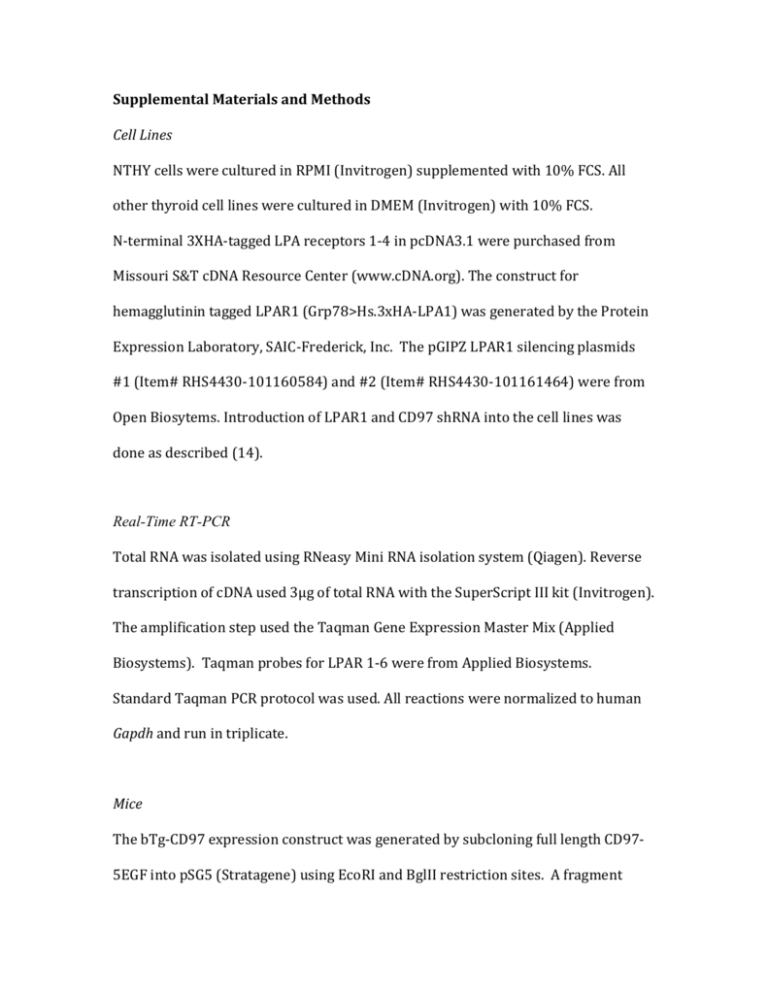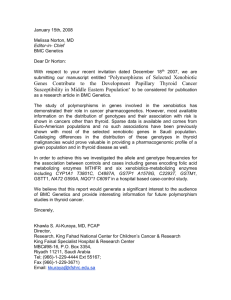Cell Lines
advertisement

Supplemental Materials and Methods Cell Lines NTHY cells were cultured in RPMI (Invitrogen) supplemented with 10% FCS. All other thyroid cell lines were cultured in DMEM (Invitrogen) with 10% FCS. N-terminal 3XHA-tagged LPA receptors 1-4 in pcDNA3.1 were purchased from Missouri S&T cDNA Resource Center (www.cDNA.org). The construct for hemagglutinin tagged LPAR1 (Grp78>Hs.3xHA-LPA1) was generated by the Protein Expression Laboratory, SAIC-Frederick, Inc. The pGIPZ LPAR1 silencing plasmids #1 (Item# RHS4430-101160584) and #2 (Item# RHS4430-101161464) were from Open Biosytems. Introduction of LPAR1 and CD97 shRNA into the cell lines was done as described (14). Real-Time RT-PCR Total RNA was isolated using RNeasy Mini RNA isolation system (Qiagen). Reverse transcription of cDNA used 3μg of total RNA with the SuperScript III kit (Invitrogen). The amplification step used the Taqman Gene Expression Master Mix (Applied Biosystems). Taqman probes for LPAR 1-6 were from Applied Biosystems. Standard Taqman PCR protocol was used. All reactions were normalized to human Gapdh and run in triplicate. Mice The bTg-CD97 expression construct was generated by subcloning full length CD975EGF into pSG5 (Stratagene) using EcoRI and BglII restriction sites. A fragment containing a beta-globin intron, CD97-5EGF, and SV40-polyA was cut from the pSG5 construct and cloned into the pBSK vector (Stratagene) downstream of a bovine thyroglobulin promoter using Cla1 and SalI restriction sites. The 6 kb transgene DNA fragment was released by SpeI and KpnI digestion, isolated by gel purification, and microinjected into fertilized FVB/N mouse eggs (SAIC, Frederick). Mice were genotyped using the 5′-primer (HCD97-S): 5′-GAAGTCGACATGGGAGGCCGCGTCTTTC, and the 3′-primer (HCD97-AS): 5′GAACTGTCATCATATGCCGGACTCTGATGC. PCR reactions were carried out for 30 cycles (95°C, 30 sec; 62°C, 30 sec; 72°C, 2 min 35 sec) using TaKaRa Ex Taq polymerase (Clontech). ThrbPV mice were genotyped as described (20). BTg-CD97 mice were crossed with ThrbPV mice to generate ThrbPV/PV CD97(+) and ThrbPV/+ CD97(+) lines. Animals were bred, housed, and used in accordance with the Policy on Humane Care and Use of Laboratory Animals (Office of Laboratory Animal Welfare, National Institutes of Health, Bethesda, MD). Organoid Culture To establish organoid cultures of thyroid epithelial cells, thyroid tumors were minced and digested for 2hours in 1mg/ml DNAse, 1mg/ml collagenase D, and 1unit/ml dispase in F12/DMEM medium supplemented with 10% FCS (F12/D10). Organoids were washed twice with F12/D10, reuspended in 2.4ml F12/D10) and pulled through a 19 gauge needle prior to being seeded (200l per well) into 6-well PrimariaTM (Becton Dickinson) culture dishes containing F12/D10. After one week, thyroid epithelial cells were treated as required and prepared for western blot analysis following standard protocol. Supplemental Figure Legends Supplemental Figure 1. CD97 expression and function in human thyroid cell lines with known genetic alterations. Western blots showing CD97 expression and RHOGTP following starvation and stimulation with 25ng/ml EGF in four human thyroid cell lines. Data is shown for parental cells (C) and cells with depleted CD97 (Sh). pERK demonstrates strong activation by EGF. Supplemental Figure 2. LPAR expression in human thyroid cell lines. (A) Relative expression of LPAR1-6 in NTHY (N), Cal62 (C), Sw1736 (S), and BCPAP (B) as determined by qRTPCR. (B) Relative silencing of LPAR1 in human thyroid cell lines. (C) In vitro invasion of parental and two LPAR1 depleted (#1 and #2) thyroid cell lines. The chemoattractant was LPA (1M). Average of three independent experiments is shown. Error bars represent ±SEM. Proliferative capability of parental and LPAR1 depleted thyroid cancer cell lines starved or stimulated with LPA (10M). Proliferation was determined for SW1736 (D), BCPAP (E), and Cal62 (F) cells using Click-iT® EdU Imaging (Invitrogen). Percent positive cells were quantified by counting 5 fields for each cell line at each condition. Error bars represent ±SEM. ***P<0.001, **P<0.01, *P≤0.02 at a 95% confidence interval. Supplemental Figure 3. Human thyroid cancer cell lines permanently transfected with empty vector (-) or LPAR1-HA (+) were subjected to in situ proximity ligation assays. Cells were either starved or stimulated for 2hours with 10M LPA. Results were quantified using the Duolink Image Tool software. Average of three independent experiments is shown. Error bars represent ±SEM. ***P<0.0001, **P<0.001 at a 95% confidence interval. Supplemental Figure 4. CD97 expression is decreased in metastatic lesions. (A) Lung metastasis from ThrbPV/PV mouse stained with anti-mouse CD97 polyclonal antibody. Inset is at higher magnification. Note low level of membrane staining indicated by arrow. Endothelial cells and lung parenchyma express CD97. (B) Lung metastases from CD97(-) and CD97(+) ThrbPV/PV mice. Note the presence of scattered metastatic cells positive for CD97 in ThrbPV/PV CD97(+) mice. Immunostaining was performed using a polyclonal antibody directed against human CD97. Scale bars: 20M. Supplemental Figure 5. Comparative survival of ThrbPV/PV mice expressing or lacking the CD97 transgene. Kaplan-Meier survival curves for mice up to 68 weeks of age. The lines are not significantly different P = 0.27. Supplemental Figure 6. CD97 expression does not affect relative tumor size in ThrbPV/PV mice. (A) Average tumor area was determined for two thyroid sections cut through the center of the thyroid for each mouse. Slides were scanned on a MicroTek ArtixScan 4000tf to generate images and area was quantified using Axiovision software. Error bars represent SEM (B) Whole thyroids were weighed on a Sartorius analytical balance. Error bars represent SEM. Supplemental Figure 7. CD97 expression patterns in (A) papillary carcinomas (PTC and FV-PTC) and (B) follicular carcinomas parallel expression of pERK, pAKT, and Ki67 in TMA #1. The expression pattern was considered the same if both components were negative or both were expressed (≥5% positive cells).








